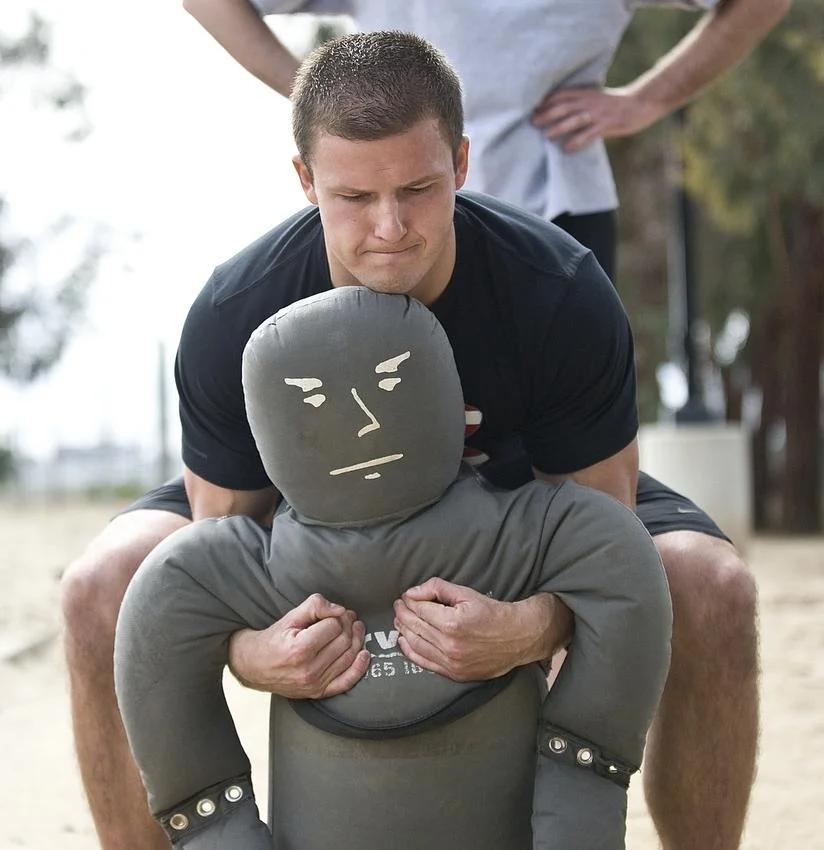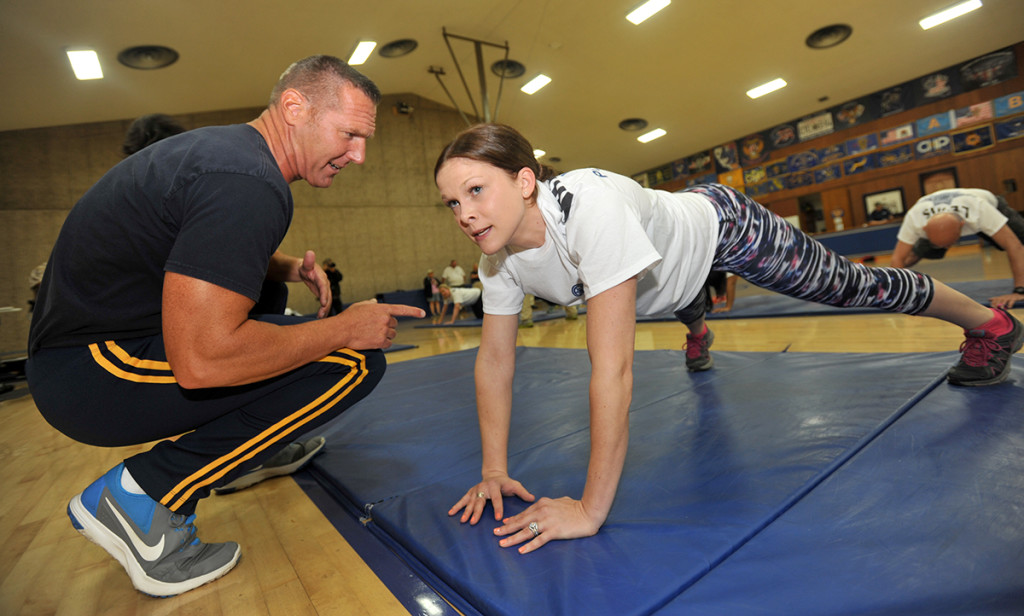Police Physical Abilities Test (PAT)
Candidates ultimately selected as police officers will be entering one of the most physically demanding professions. Police work requires continuous physical readiness in its day to day duties.
The Police Officer Physical Abilities Test (POPAT or PAT) is a highly regulated selection procedure that is a major challenge for most candidates. Commitment and preparation are required in order to pass. Whether the department you're applying with calls it PAT, POPAT, PTT, POPS, POWER or PAA, the police physical abilities test is always pass/fail and a true gut-buster.
Most departments have you take the physical abilities test after you past the police written exam. However, some agencies believe that it is more cost effective to conduct the physical abilities test first, in order to avoid the cost of administering the written test.
Mental Preparation for the Police Physical Abilities Test
You must be more than fit, more than strong, more than willing. You must be ready to perform as though lives depend on it. Fortunately, on test day, only your life as a continuing candidate is on the line. That risk should motivate you to get you fired up.
This test is nothing like gym class or working out in your athletic club. It is meant to tax your body, push your reflexes and prey on your instincts. You will be scored on your ability to perform specific tasks and activities that will show clearly if you can perform the duties of a police officer. This is a physical screening program. It is meant to do only one thing: weed out those who can't cut it.
Come to this challenge armed with enthusiasm and anticipation of excellence. You need to be fit, clear-headed and ready to rumble.
Learn About the "Cooper Standards"
The majority of police, sheriff and state trooper departments in this country use all, or parts of, the "Cooper Standards". These are testing standards designed by the Cooper Institute of Aerobics Research, located in Dallas, Texas and founded in 1970.
If you feel you are generally fit and you do one-hour cross-training workouts 3 times a week, you should start targeting your training for the police physical ability test 4 weeks prior to the test. If you are fit, but not in a regular exercise regimen, it is advised to begin training 8-12 weeks prior to your physical ability test.
Do not try to take your physical ability test without knowing what activities the test involves. Department websites can give you detailed information. If not, call and ask. The most common requirements are described in the following paragraphs.
1 - The 1.5 Mile Run
The first test criteria you need to prepare for is the 1.5 mile run.
Every department has this strength criterion in their physical ability testing. The run must be completed within the allotted time to pass. That time can be anywhere from 16 minutes 30 seconds to 21 minutes. Many departments start their physical assessment with this event—if you don't pass, you don't move on—period.
Many departments have 'pursuit' runs in addition to the 1.5 mile run. These are not obstacle runs, but are sprints from standing. They vary between 60 and 100 yards long with passing times of 65 to 85 seconds. Some include a fence climb at the end of the sprint.
2 - Police Obstacle Course
The second test criterion to prepare for is the obstacle course.
Obstacle courses are designed to test as many aspects as possible of suspect pursuits and are extremely demanding. Check with your department on whether their course is open for training, and if it is, make sure you use that opportunity until you can run the course with ease. Departments want candidates to succeed and if their course isn't open for training, you can probably get a diagram of it. If you do, find a spot to set up part, or all, of the course—then practice running it until you could run it back to back without hesitation. Remember, police officers don't run down one suspect and call it a day. You have to be prepared to do this as often as your duties demand.
Obstacle courses are timed, usually carrying completion times of less than 4 minutes, and average around 400 yards. Some are done as 'laps'—shorter sprints, drag distances and stairs—that may be repeated as many as 6 times to pass the course. Your score can be affected by your finish time, the cones you knocked over, the stairs you skipped, the times you dropped the 'victim', if you grabbed a railing for support or you didn't follow the course correctly.
Keep in mind that the main purpose of the obstacle course is to test your ability to pursue and subdue a suspect. Courses include jumping barriers (3' to 6' high), running up and down stairs, negotiating low barriers and lifting/dragging a dummy weighing between 125 to 165 pounds a total of 30 to 60 feet. Some courses also include climbing ladders, climbing through windows, crawling through pipes and dodging hanging objects.
Many departments also require candidates to wear a 3-pound vest, or a holster and training gun, or a nightstick while performing the obstacle course. Your training should take this into account, or your performance could be thrown off by the extra bulk and weight.
3 - Strength Assessment
“Good Preparation is Essential if you Expect to Pass the Police Physical Abilities Test.”
”
The final test criterion to prepare for is the 'calisthenics' assessments. These tests include bench press, sit ups, push-ups and sit/reach extensions. Each of these is scored by different factors.
Bench press: a one-time lift that is scored by the percentage of your body weight you lifted.
Sit ups: the number of sit ups performed, following specific form rules, in 1 minute (standards vary from 18 to 34 per minute).
Push-ups: the number of push-ups performed, following specific form-rules, in 1 minute (standard is usually 20).
Sit/Reach Extensions: while maintaining a seated position on the floor, the distance fingers can be extended beyond toes-in inches.
Additional strength assessments may include the Trigger Pull, to test grip strength; the Arm Ergo-meter, to test forearm strength; and the stationary bike, to test leg strength.
It is essential to train for the physical ability test. It is essential to have a regular form of physical exercise in place to help you maintain your fitness as a police officer. Your safety and the safety of others depend on your being fit for duty every day.
30 Day Preparation Plan for the Police Physical Abilities Test
Here is a very good 30-day plan for preparing for your police physical fitness test. It is courtesy of the Tucson Police department. The plan covers nutrition as well as training and is easy to follow.
48 Hours Before Your Physical Abilities Test
“Each agency will be slightly different, so you must check to determine what exactly will be required during your Physical Abilities Test.””
Your test date is in 2 days. You've trained well and feel great. You want to push hard right up to the last minute in preparation. Don't! It's best to ease off and avoid strenuous exercise 48 hours before your physical assessment test. Allow your body to relax and rest. Get good sleep and drink plenty of water to ensure hydration. Avoid caffeine and eat light, and early, the day of your test.
Finally, the day of your test arrives. You are psyched and ready to rocket through your assessment. You've had a good sleep, a light breakfast and you're well hydrated. You're dressed in comfortable clothing, appropriate to strenuous exercise, and your shoes are rubber-soled and fit well. If allowed, and you've opted for them, you have gloves and knee-pads ready.
Next, be sure you leave early. Do not be late for your test!
When you arrive, take time to warm up and stretch. This relaxes you and brings your body up to speed.
Finally, take a moment to focus on what you're getting ready to do. Visualize the suspect you're going to chase. Let your adrenaline flow. Own the moment… because your next stop is the finish line—and the beginning of your life as a police officer.









